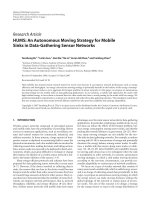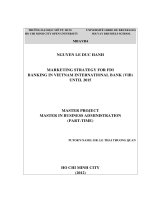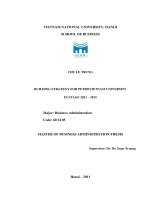building strategy for petrovietnam university in stage 2011-2015
Bạn đang xem bản rút gọn của tài liệu. Xem và tải ngay bản đầy đủ của tài liệu tại đây (1.6 MB, 107 trang )
VIETNAM NATIONAL UNIVERSITY, HANOI
SCHOOL OF BUSINESS
CHU LE TRUNG
BUILDING STRATEGY FOR PETROVIETNAM UNIVERSITY
IN STAGE 2011 – 2015
Major: Business Administration
Code: 60 34 05
MASTER OF BUSINESS ADMINISTRATION THESIS
Supervisor: Dr. Do Xuan Truong
Hanoi – 2011
TABLE OF CONTENT
ACKNOWLEDGEMENTS .....................................................................................i
ABSTRACT ............................................................................................................ ii
TÓM TẮT ...............................................................................................................iv
TABLE OF CONTENT .........................................................................................vi
LIST OF ABBREVIATIONS ................................................................................ix
LIST OF TABLES .................................................................................................. x
LIST OF FIGURES ...............................................................................................xi
INTRODUCTION ................................................................................................ xii
1.
Necessity of the thesis ................................................................................... xii
2.
Objectives of the thesis ................................................................................. xii
3.
Research Questions ...................................................................................... xii
4.
Scope of works ............................................................................................. xiii
5.
Data source................................................................................................... xiii
6.
Expected Results .......................................................................................... xiii
7.
Structure of the thesis ................................................................................. xiii
CHAPTER 1: LITERATURE REVIEW .............................................................. 1
1.
Strategy and role of strategy ........................................................................... 1
1.1
Definition of strategy ................................................................................. 1
1.2
Role of strategy.......................................................................................... 2
2.
Strategic management process ....................................................................... 3
3.
Strategic vision and business mission............................................................. 6
vi
4.
Setting objectives ............................................................................................. 6
5.
External environment analysis ....................................................................... 7
5.1
Macro environment analysis ...................................................................... 8
5.2
Industry analysis: Porter‟s Five Forces model ........................................... 9
6.
Internal analysis ............................................................................................ 15
6.1
Value chain analysis ................................................................................ 15
6.2
Process to identify sustainable competitive advantages ........................... 17
7.
SWOT analysis .............................................................................................. 18
7.1
What is SWOT? ....................................................................................... 18
7.2
SWOT matrix .......................................................................................... 20
8.
Strategy selection ........................................................................................... 20
8.1
Suitability ................................................................................................ 20
8.2
Acceptability ........................................................................................... 21
8.3
Feasibility ................................................................................................ 21
9.
Formulating a strategy .................................................................................. 22
9.1
Levels of strategy - The Strategy making pyramid .................................. 22
9.2
Specific strategy at different levels .......................................................... 23
10.
Strategy implementation ........................................................................... 29
11.
Strategy evaluation .................................................................................... 30
CHAPTER 2: ANALYZE THE CASE OF ......................................................... 31
PETROVIETNAM UNIVERSITY - PVU ........................................................... 31
1.
PVU Project – The imperative...................................................................... 31
1.1
Overview about PetroVietnam – PVN ..................................................... 32
vii
1.2
2.
Overview about PetroVietnam University – PVU ................................... 46
External environment analysis ..................................................................... 54
2.1
2.2
3.
Macro analysis – PEST model ................................................................. 54
Industry analysis – Five forces model ..................................................... 60
SWOT analysis .............................................................................................. 66
3.1
Strengths .................................................................................................. 66
3.2
Weeknesses ............................................................................................. 67
3.3
Oppotunities ............................................................................................ 69
3.4
Threats ..................................................................................................... 70
CHAPTER 3: STRATEGY FORMULATION AND IMPLEMETATION...... 72
1.
Strategy formulation ..................................................................................... 72
1.1
1.2
Strategy formulation ................................................................................ 77
1.3
2.
SWOT Matrix .......................................................................................... 72
Strategy slection ...................................................................................... 82
Implementation .............................................................................................. 85
2.1
Action plan of Organisational management & Policy strategy ................ 86
2.2
Action plan of Marketing strategy ........................................................... 88
CONCLUSION ...................................................................................................... 92
REFERENCES ...................................................................................................... 93
APPENDIX 1 ......................................................................................................... 96
APPENDIX 2 ......................................................................................................... 97
APPENDIX 3 ......................................................................................................... 98
viii
LIST OF ABBREVIATIONS
PVN
Vietnam Oil and Gas Group
PVU
PetroVietnam University
MOET
Ministry of Education and Training
SWOT
Strengths, Weaknesses, Opportunities, Threats
GREAT
Gain, Risk, Expense, Achievable, Time
PEST
Politics, Economics, Social, Technology
JVC
Join Venture Company
IT
Information Technology
ICT
Information Communication Technology
JOT
On the job training
JOC
Join Operation Company
GDP
Gross Domestic Product
DPU
Danang Polytechnic University
HPU
Ho Chi Minh Polytechnic University
HUMG
Hanoi University of Mining and Geology
HUT
Hanoi University of Technology
PVMTC
PetroVietnam Manpower Training College
PVFC
PetroVietnam Finance Company
VPI
Vietnam Petroleum Institute
PR
Public Relation
ABET
Accreditation Board for Engineering and Technology
TIEC
Texas International Education Consortium
ix
LIST OF TABLES
Table 1.1
Industry‟s entry and exit barriers
Table 1.2
Bargaining powers of suppliers and buyers
Table 1.3
Model of SWOT matrix
Table 1.4
Appropriate strategies selection (GREAT model)
Table 2.1
Estimated number of employees needed in period 2016 – 2025 of PVN
Table 2.2
Vietnam GDP Growth rate 2006 - 2010
Table 2.3
Statistics of Vietnam University Education
Table 2.4
SWOT Analysis
Table 3.1
Strengths – Opportunities Strategies ( S – O strategies)
Table 3.2
Strengths – Threats Strategies (S – T strategies)
Table 3.3
Weaknesses – Opportunities strategies ( W – O strategies)
Table 3.4
Weaknesses – Threats Strategies ( W – T strategies)
Table 3.5
PVU‟s appropriate strategies selection (GREAT model)
Table 3.6
Action plan of Organizational management & Policy strategy
Table 3.7
Action plan of Marketing strategy
x
LIST OF FIGURES
Figure 1.1 Strategic management Model
Figure 1.2 External environment
Figure 1.3 Five Forces Model
Figure 1.4 Value chain
Figure 1.5 Process to identify sustainable competitive advantages
Figure 1.6 The strategic making pyramid model in a diversified company
Figure 1.7 Model of business strategies
Figure 2.1 Logo Petro Vietnam
Figure 2.2 The Number of employees of PVN in 2010
Figure 2.3 The structure and level of labor PVN in 2010
Figure 2.4 The structure of working age PVN in 2010
Figure 2.5 Logo PetroVietnam University
Figure 2.6 3D model views of PVU‟s Main campus in Vinh Phuc
Figure 2.7 Socialize education model
Figure 2.8 Vietnam GDP Growth rate 2006 – 2010
Figure 2.9 Vietnam Population Pyramid 2010
xi
INTRODUCTION
This part will give an introduction to readers about the thesis. Firstly, the necessity
of the thesis is mentioned, next are objectives of the thesis, then researches
questions are raised up, followed by scope of work, methodology, thesis„s
contributions, expected results, further research directions and limitations of the
thesis. Finally, the thesis structure is presented in order to help readers have an
over-all picture of the whole study.
1. Necessity of the thesis
-
PVU has just been established in the early of 2011, PVU have the business
level strategy very clear is Diffirentiation strategy. But they didn‟t have clear
functional strategies and “what are most important fields must be focus” is
big question for them in this stage.
-
PVN and PVU‟s managers desire to build PVU as a international university;
become one of the best universities in Vietnam and area on 2020s.
-
Almost international universities have the clear strategy. This shows the
necessity of building the strategy in order to make differences with other
universities as well as designing a development pathlength for the university
itself.
2. Objectives of the thesis
-
Review the theory in strategy and strategic management
-
Analyze the case of PetroVietnam University in the first stage
-
Propose some recommendations in order to build the strategy of PVN in
stage 2011-2015
3. Research Questions
-
What is strategy and what is the role of strategy?
-
Which factors will affect to build strategy of PVU
-
Which strategy will be suitable for PVU in the very first state
xii
4. Scope of works
-
Field: Strategy and strategy management
-
Space: All activities of PVU
-
Time: About 5 years from the establishment 2011 - 2015
5. Data source
-
Strategy in new stage of PVN
-
Consulting project of PVN with TIEC
-
Internet, books and ebooks
-
Experts (Manager of PVU, Educational expert…)
6. Expected Results
-
Giving out a general picture of the educational field
-
Giving out a deep analysis about the case of PVU
-
Propose some recommendations for functional level strategy for PVU in the
stage 2011 - 2015
7. Structure of the thesis
INTRODUCTION
CHAPTER I: LITERATURE REVIEW
CHAPTER II: ANALYSE THE CASE OF PETROVIETNAM UNIVERSITY
CHAPTER III: STRATEGY FORMULATION AND RECOMENDATION
CONCLUSION
REFERENCE
APPENDIX
xiii
CHAPTER 1: LITERATURE REVIEW
Literature review is an important chapter of any thesis; it helps readers to remind
about strategic theories relating to the thesis‟s topic. In this chapter, the theory in
strategy and strategic management will be reviewed as a basic for analyses in next
chapters.
1. Strategy and role of strategy
1.1 Definition of strategy
Strategy is a broad term which covers all of the activities of an organization. In the
theoretical base, there are various definitions about strategy.
Professor Arthur Thompson and Strickland, in their book Strategic Management1
defined “strategy” as a “game plan” management has for positioning the company
in its chosen market arena, competing successfully, satisfying customers, and
achieving good business performance. In this definition, the term of “positioning” is
emphasized, as Thompson saw the importance of identifying clearly the positioning
of the company in the market.
Dr. Erica Olsen, in her book “Strategic Planning for Dummies”, has given another
definition: “Strategy means consciously choosing to be clear about your company‟s
direction in relation to what‟s happening in the dynamic environment. With this
knowledge, you‟re in a much better position to respond proactively to the changing
environment”.
Professor Michael L.Porter of Harvard University, USA, has stated his own
viewpoints in the article “What is strategy?” in Harvard Business Review. In his
opinion, strategy is performing different activities from rivals‟ or performing
similar activities in different ways. It is the creation of a unique and valuable
1
Arthur Thompson and Stricklands, Strategic Management: Concepts and Cases,10th edition, McGraw Hill
1
position, involving a different set of activities. Strategy, therefore, is quite different
from “Operational Effectiveness (OE) which is only “Performing similar activities
better than rivals perform them”. Although both operational effectiveness and
strategy are necessary for the superior performance of an organization, they operate
in different ways.
From the viewpoint, it can be seen that a company can overcome rivals only if it
can establish a difference it can preserve and maintain this. He also points out some
certain core points when mentioning strategy:
Strategy depends on unique activities. Competitive strategy is about being different.
It means deliberately choosing a different set of activities to deliver a unique mix of
value.
Strategy creates the fit driving Both Competitive Advantage and Sustainability. It is
considered as a system. Therefore, if a company has a sound and clear strategy, it
can create a difference system which is very difficult to imitate, and they can brings
both competitive advantage and sustainability.
From these definitions, it can be seen that although the description of strategy are
different, all authors agreed at a common viewpoint that strategy is a clear and best
way (or road map) that a company has to “choose” to go to reach success. As there
might be different ways, a company can only choose the best way and ignore others.
If not, if will go around and never reach the final destination.
1.2 Role of strategy
Strategy plays an important role in the overall business activity of the company.
Firstly, it helps the company go ahead in a clear direction, avoid being mislead in
the way ahead or go around in a circle. Secondly, a clear and sound strategy helps to
clarify and communicate within the organization and to its customers/partners, so
that all knows where the company goes and all implement this strategy in a
2
consistent and coordinated way. Thirdly, strategy helps companies to create the
competitive advantage and stimulate the sustainable development of the company in
the long-term by focus all of its resources to implement which is considered as
critical activities and to design an effective business system in order to maintain its
chosen positions in the market. By doing this way, strategy helps companies to
refuse implementing unimportant activities, therefore, save time, efforts and
resources and reinforce the strong position. It can be said that, without a sound
strategy, company hardly can maintain and develop its position in the market in the
long-term.
2. Strategic management process
The Strategic management process is a problem which is interested by many
strategists as well as economists. Simply understanding, strategic management is a
process of implementing “strategic decisions” to answer 3 main questions: 1Where is the company now? 2- Where will the company go? 3- How can the
company reach there?
As there are many different viewpoints in strategic management process, within the
limitation of this thesis, a model of Strategic management is rebuilt up based on 2
models of Thompson and Strickland (which are Five Tasks of Strategic
management model and The Strategy making pyramid model), to present the
relations among major steps in the process.
3
Figure 1.1: Strategic Management Model
Source: Based on Arthur Thompson and Strickland, Strategic Management:
Concepts and Cases, 10th edition, McGraw Hill Companies, the Five Tasks of
Strategic management Model and the Strategy Making Pyramid model.
4
It can be seen that there are several steps in that model:
-
Firstly, the strategic management process begins with the identification of
vision and mission of the company, which is to answer the questions “Where
will the company go?”
-
Secondly, the strategist should analyze the environment, including external
and internal one, this is to answer the question “Where is the company
now?” and “What does the company have?”
-
Thirdly, the strategists have to set its own objectives, these objectives is in
shorter time than the vision and mission, they might be annual or in several
years and are very specific. They can be illustrated as the milestones in the
way that the company would like to go.
-
Fourthly, after knowing the point of departure and of destination, the
strategist has to draw out how the company can reach there, by what means,
and what resources it has to prepare for, that is called a strategy.
Then, the manager will organize to implement the strategy.
During the process of strategy implementation, it needs the evaluation and
monitoring to revise if the way it goes is right and the best way and if there is
another better way to go, as the environment changes very quickly. That is why
adjustments might be made in all steps from redefining vision and mission, setting
objectives, to formulating strategy and implementation.
Therefore, it can be concluded that strategic management is an interrelated process,
not a group of single activities; all of the steps have the close relations with one
another.
Following parts in this chapter will review the theoretical aspects of this model.
5
3. Strategic vision and business mission
As described in the above part, a strategic management process begins with the
identification of vision and mission of the company.
According to Thompson and Strickland, a strategic vision is a roadmap of a
company„s future – the direction it is headed, the business position it intends to
stake out, and the capabilities it plans to develop. A company‟s mission is what a
company is currently seeking to do for its customers. From these definitions, it can
be seen that the vision is for the long-term future of the company, while the mission
is for the current business. If a company „s mission does not only include the current
business but also mention where the company is headed and what it will become in
the future, then the mission merge into the vision, or we have both vision and
mission in one statement.
To become effectively communicate within and outside of the company, a
company„s vision and mission should meet ensure following characters: 1- The
current business of the company. 2- The long-term strategic course that the
company will pursue. 3- The statement should be clear, exciting, and inspiring.
Normally, the vision and mission is not to make a profit and therefore, not related to
specific figures and numbers.
4. Setting objectives
The third step after establishing strategic vision and business mission in the model
is setting objectives. Objectives can be defined as specific performance target
converted from the vision and mission. They represent the commitment of leaders
to achieve specific performance targets within a specific time frame. Without
objectives, vision and mission are only dreams.
Unlike vision and mission, objectives should be very specific and can be illustrated
by numbers and figures. In general, objectives are divided into 2 types:
6
-
Financial objectives: They are related to financial performance like growth in
revenues and earnings, reduction in cost, higher dividends, better financial
ratio (Return on assets, return on equity, earning per share …)
-
Strategic objectives: They are related to other non-financial performance like
higher product quality and customer service than competitors, a bigger
market share, higher brand awareness, more loyalty of customers, more
qualified human resource…
5. External environment analysis
External environment is the environment which affects directly or indirectly to the
activities of a company but the company hardly impacts or changes this. It includes
macro environment (economics, politics, socio-cultural and technology) and
industry (or competitive) environment, which can be illustrated in the following
figure. This environment creates opportunities or threats for the company.
Figure 1.2: External environment
Source: www.bolender.com
7
5.1 Macro environment analysis
When mentioning macro environment, the “PEST” analysis technique is often used,
that is the analysis of 4 factors “Politics, Economics, Socio-culture and
Technology”.
5.1.1 Analyze political-legal environment
The goal of the analysis in political-legal environment is to identify impacts of
politics and legal system on the stable and sustainable development of the
organization. Legal environment includes legal system and politic system (like
policies of the Government, politic environment in both domestic and international).
A politic stability and an open, convenient legal environment will facilitate
investors to start up and develop their organization in the long run.
5.1.2 Analyze economic environment
The economic environment is factors and forces which impact the capability of
production and supplying (supply factor) as well as and the ability and willing to
buy product/services (demand factor). Some most important factors of the economic
environment are the economic system, economy condition, interest rate, inflation
rate and exchange rate.
5.1.3 Analyze socio-cultural environment
Socio-cultural environment includes values and standards accepted and respected
by a society or a specific culture, including viewpoints in lifestyle and consuming;
attitude, traditional habits and customs; interests of the society; level of knowledge.
To identify and catch up with consuming tendencies will bring competitiveness and
success for the company. The main goal of analysis the social-cultural environment
is the attitude and behavior of actors and customers who have a direct relationship
with the company. The social environment also includes factors like population, the
growth rate and distribution of the population, structure of age and gender, income.
8
Analysis of these factors will help the company to estimate the market volume and
exploit the right characteristics of the market to look for a profit.
5.1.4 Analyze technology environment
Technology progress is a basic factor to develop the economy. In developing
countries with low technology level like Vietnam, the successful transfer and
adoption of technology from foreign countries decide the sustainable growth of the
economy.
The development of technology, especially information and communication
technology affect positively to the activity of a company in all activities. First, it
decreases the cost of transportation and communication. Secondly, it promotes the
innovation and creativeness, increases productivity and creates new added values.
Thirdly, information technology and communication combine with other
technologies are useful means to enhance the management effectiveness. Fourthly,
it can affect to the barrier of entrance into the industry and quickly restructure the
competition within the industry.
Therefore, one of important things that a company needs to do is usually research
on new technology, development level of technology,… to take opportunities
brought by technology progress in order to enhance its competitiveness.
5.2 Industry analysis: Porter’s Five Forces model
Porter‟s five forces framework evaluates entry barriers, suppliers, customers,
substitute products, and rivalry in the industry.
9
Figure 1.3: Five Forces Model
Source: Michael Porter, 1980
Those five competitive forces appear in every industry and every market. They
determine the intensity of competition and therefore the profitability and
attractiveness of an industry. Based on the information derived from the Five Forces
analysis, managers can decide how to influence or to exploit particular
characteristics of their industry to improve the firm‟s position.
5.2.1 Intensity of Rivalry
This force describes the intensity of competition between existing players in an
industry in which firms strive for a competitive advantage over their rivals.
Economists measure rivalry by indicators of industry concentration. A high
concentration ratio indicates that the largest firms hold a high concentration of
10
market share; the industry is concentrated or less competitive. A low concentration
ratio indicates that many rivals, none of which has a significant market share,
characterize the industry. The market is competitive.
The intensity of rivalry is commonly based on the firms‟ aggressiveness in order to
gain an advantage. It is influenced by the industry characteristics such as:
-
The number of competitors: A large numbers of competitors increase rivalry
because more firms must compete for the same customers and resources. The
rivalry is more intense if there are many small or equally sized competitors;
rivalry is less when an industry has a market leader.
-
Market growth: In a slow growth market, firms have to compete for market
share. On the contrary, firms are easy to improve revenues in an expanding
market.
-
High fixed costs: If total costs are mostly fixed costs, the firm must produce
near capacity to attain the lowest unit costs. The firm must sell a large
quantity of product, that lead to a fight for market share and an increase in
rivalry.
-
Level of product differentiation: Low level of product differentiation is
associated with higher level of rivalry. Industries where products are
commodities have greater rivalry, industries where competitors can
differentiate their products have less rivalry.
-
Switching costs: Rivalry is reduced if there is a significant cost associated
with the decision to buy a product from an alternative supplier.
5.2.2 Threat of New Entrants
It is not only existing rivals that make a threat to firms in an industry, the possibility
that new firms may enter the industry also affects competition. New entrants to an
11
industry can raise the level of competition, thereby reducing its attractiveness.
However, there are barriers to entry.
Barriers to entry are unique industry characteristics. Barriers maintain the level of
profits for those already in the industry because they reduce the rate of new
entrants. Barriers to entry arise from several sources such as:
-
Government regulations: The principal role of the government in a market is
to preserve competition through anti-trust actions. Besides, government
restricts competition through regulations. Industries such as public utilities
are considered natural monopolies, as it has been more efficient to have one
company rather than to permit many companies to compete in a local market.
-
Patents and proprietary knowledge: Ideas and knowledge that provide
competitive advantages are considered private property, so that, preventing
others from using the knowledge and thus creating a barrier to entry.
-
Asset specificity: Asset specificity is the extent to which the firm‟s assets can
be utilized to produce a different product. Potential entrants are reluctant to
invest in highly specialized assets that cannot be sold or converted into other
uses.
-
Economies of Scale: The existence of an economy of scale (minimum size
requirements for profitable operations) creates a barrier to entry.
-
Exit barriers: Barriers to exit are similar to barriers to entry. Exit barriers
limit the ability of a firm to leave the market. High barriers to leave an
industry increase rivalry. High exit barriers cause a firm to remain in an
industry, even when the business is not profitable. A common exit barrier is
asset specificity. If the plant and equipment required for manufacturing a
product is highly specialized, they cannot easily be sold to other buyers in
another industry.
12
Table 1.1: Industry’s entry and exit barriers
Easy to Enter if
Difficult to Enter if
-
Common technology
-
Patented or proprietary know-how
-
Little brand franchise
-
Difficulty in brand switching
-
Access to distribution channels
-
Restricted distribution channels
-
Low scale threshold
-
High scale threshold
Easy to Exit if
Difficult to Exit if
-
Salable assets
-
Specialized assets
-
Low exit costs
-
High exit costs
-
Independent businesses
-
Interrelated businesses
5.2.3 Bargaining Power of Buyers
Buyers are the people or organizations who create demand in an industry. The
power of buyers is the impact that customers have on a producing industry.
If buyer power is strong, the relationship to the producing industry is near to a
monopoly, a market in which there are many suppliers and one buyer. Under such
market conditions, the buyer sets the price.
5.2.4 Bargaining Power of Suppliers
Suppliers can have a significant impact on a company‟s profitability. If suppliers
have high bargaining power over a company, then the company‟s industry is less
attractive.
13
A producing industry requires raw materials, labor, components… This requirement
leads to buyer-supplier relationships between the industry and the firms that provide
the materials used to create products. Suppliers, if powerful, can influent the
producing industry, such as selling at a high price to capture some of the industry‟s
profits.
The industry often faces a high pressure from their suppliers or buyers. This
relationship can potentially affect its profitability.
Table 1.2: Bargaining powers of suppliers and buyers
Buyers are powerful if
-
A few buyers with significant
Buyers are weak if
-
market share and many sellers
-
-
product or price
-
Buyers
threaten
backward
Significant switching costs
-
Producers
integration
threaten
forward
integration
Supplier is powerful if
-
Producer can take over own
distribution or retailing
Low switching costs: products are
standardized
-
has any particular influence on
The industry is not a key supplying
group
Many different buyers, no buyer
Suppliers are weak if
-
Many competitive suppliers
suppliers
-
Many buyers and few dominant
-
Low switching costs: products are
No substitutes for the particular
standardized
input
-
-
Purchase commodity product
High switching costs from one
-
The industry is a key customer
supplier to another
14
-
The industry is not a key
customer
-
Suppliers
-
Buyers
threaten
backward
integration
threaten
forward
integration
5.2.5 Threat of Substitutes
In the Five Forces model, substitute products refer to products in other industries. A
threat of substitutes exists when a product‟s demand is affected by the price change
of a substitute product (product‟s price elasticity). The more substitutes are
available, the more elastic the demand becomes. Not only constrains the firms‟
ability to raise prices, the substitute products also lower industry attractiveness and
profitability.
The threat of substitutes is determined by factors like:
-
Brand loyalty of customers
-
Close customer relationships
-
Switching costs for customers
-
The relative price for performance of substitutes
-
Current trends
6. Internal analysis
6.1 Value chain analysis
15
Figure 1-4: Value chain
The principle idea of value chain is to identify the relevant activities in business‟s
performance. The purpose is to analysis each acitivities to find out the role of each
activities and its contribution in final products of the business. Value chain is
defined as a chain of activities. The final products pass through all activities in the
value chain. And at each activity, the products gain some added value. The valuable
meaning in this concept is that the chain of activities contributes to final products
more added value than summing up individually added value of each activities.
The value chain divides all activities of an organization into 2 categorizese: primary
activities and support activities.
The primary activities include inbound logistic, operations, outbound logistic,
marketing and sales, and service.
The support activities include administrative infrastructure management, human
resource management, information technology, and procurement.
16









